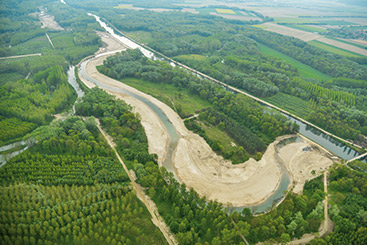Hydromorphology: the Danube perspective

Hydromorphology: the Danube perspective
In 2000, the ground-breaking EU Water Framework Directive (WFD) introduced a new legal basis for modern water management. Since then, any water use has to be sustainable, ensuring that the environmental objectives of maintaining good chemical and ecological status are achieved in all surface water bodies.

© Verbund / Haslinger
Since the EUWFD entered into force, rivers are recognised not only as diluters for (treated) waste water discharges or water supply for industrial uses, but also as ecosystems, which have to be protected and enhanced.
The holistic view of rivers and lakes is that as well as (physico-) chemical conditions, type-specific hydrological, morphological and river continuity (hydromorphological) aspects of the Danube are crucial for the good functioning of the aquatic environment. The specific hydromorphological components that are relevant to ecological status and support the biology of a water body are listed in the table below.
Hydrological regime
Quantity and dynamics of flow
Connection to groundwater bodies
River continuity
for aquatic organisms
for sediment transport
Morphology
River depth and width variations
Structure and substrate of river bed
Structure and conditions of riparian zone
Flow velocities
In 2004, the ICPDR performed the Danube Basin Analysis. It identified flood protection, hydropower and navigation as the main drivers responsible for significant alteration of the hydromorphological (‘hymo’) conditions in the Danube and its larger tributaries. As hymo modifications and their impacts posed a considerable risk that water bodies would fail to meet the environmental objective of having good ecological status, “hydromorphological alterations” were declared to be one of the
“significant water management issues” of basin wide importance.
The key hydromorphological pressures in the Danube basin include the disruption of longitudinal ecological continuity; the alteration of river morphology and habitats; the disconnection of adjacent wetlands, floodplains and impoundments; and water abstractions or diversions and hydropeaking (abrupt flow fluctuations due to electricity production on demand).
The 1st Danube Basin Management Plan set operational management objectives for hymo alterations. Because of the high number of pressures, restoration measures have to be gradually implemented and prioritised. The measures of 2009-2015 were successfully implemented with regard to:
- Restoration of river continuity and construction of more than 100 fish migration aids,
- Reconnection and hydrological improvement of more than 50,000 ha of wetlands and floodplains, and
- Restoration of ecological flows, measures at impoundments or addressing hydropeaking in dozens of cases.
Many pressures have not yet been solved, for example there are more than 600 migration barriers. Further effort will have to be made in the coming years. Synergies with flood management can contribute to costeffective solutions. Inter-sectoral cooperation, especially with the hydropower and navigation sector, is key to ensure the sustainability of future infrastructure projects and to minimise impacts on water status.





